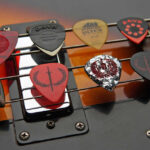For aficionados of vintage guitars and the legendary sound of Django Reinhardt, few instruments hold as much mystique as the pre-production Selmer Guitar. This remarkable instrument represents a pivotal moment in guitar history, predating the official serial numbering of Selmer guitars and emerging from the visionary direction of Mario Maccaferri. With only a handful of these initial creations surviving, they are rightfully considered holy grails for both collectors and discerning players.
These early, pre-production models, all bearing serial numbers below 100, showcase distinctive characteristics that set them apart. One telltale sign is the engraved bakelite label meticulously mounted on the internal resonator, a feature unique to these nascent instruments. Furthermore, the serial number itself is elegantly engraved on the headstock’s top, a subtle yet significant detail. Adding to their pedigree, the headstock proudly displays Maccaferri’s name alongside “PAT. Nº 10.431”, solidifying its connection to the pioneering luthier. Another distinguishing feature is the “stair stepped” tailpiece, complete with an ebony saddle and a tortoise insert – a design choice that evolved into the more commonly seen rounded tailpiece in later models. Interestingly, these initial guitars were originally crafted without fingerboard dots, though many, like the exceptional example discussed here, have had inlays and dots added over time for enhanced playability.
Adding to the extraordinary nature of this particular instrument is its construction featuring macassar ebony back and sides. To the best of current knowledge, this marks it as the sole Selmer guitar ever crafted using this exquisite tonewood, further elevating its rarity and desirability.
Beyond these unique pre-production traits, this guitar aligns with the specifications of the “Orchestre” model, also known as the “Jazz” model, produced by Selmer from 1932 to 1934. This was before Maccaferri’s departure and the subsequent transitional period that led to the development of the iconic “petite bouche” model, which Selmer continued to build until 1952. The Orchestre model achieved lasting fame through Django Reinhardt’s groundbreaking early recordings with the Hot Club of France. Moreover, Django’s contemporaries and fellow musicians within the Hot Club, including Joseph Reinhardt, Roger Chaput, and Baro Ferret, also extensively utilized the Orchestre model, as did Argentinian guitar virtuoso Oscar Aleman, further cementing its place in jazz guitar history.
Pre-war Selmer guitars, in any form, are exceptionally scarce, but well-preserved Orchestre models stand out as among the most elusive. This featured example is remarkably well-preserved, boasting its original internal resonator, a component often removed from other guitars or omitted in later Orchestre iterations. It retains all original hardware, including a fully functional set of HSC tuners and the rare, early “stair stepped” version of the HSC tailpiece adorned with a tortoise insert. The guitar’s life has seen only minor, player-centric modifications: the addition of banjo-style fingerboard inlays, new frets ensuring optimal playability, and a replaced bridge. A small, stable crack beneath the pickguard, secured by braces and the pickguard itself, and possibly a couple of hairline top cracks in the upper bouts (their full depth obscured by the resonator, but appearing stable) are minor imperfections consistent with the age of such an instrument.
Professionally set up, this Selmer guitar offers effortless playability with a comfortable 2.6mm action. However, the true revelation lies in its sound. The sonic character of this instrument transcends expectations, delivering an astonishing volume that seems to defy its construction, coupled with a tone that embodies the dreams of guitarists. It possesses the rare ability to project a lush, rounded tone, rich and full without becoming overly dark or indistinct. Chords resonate with an almost symphonic grandeur, pushing the boundaries of auditory perception, while single notes evoke the warm, punchy character of a flugelhorn. While guitar preferences are subjective, it’s challenging to imagine any guitarist, regardless of genre, who wouldn’t be captivated by the exceptional qualities of this instrument.
Adding to its allure, a rare video exists showcasing a young Bireli Lagrene masterfully playing this very guitar, a testament to its enduring appeal and exceptional sound.
With well-preserved Maccaferri Orchestre models recently fetching prices around $50,000, this outstanding example presents a compelling opportunity to acquire a stellar instrument at a price below market value.

